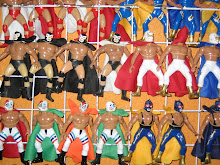 My plane hit the tarmac at approximately 5:15 am in Maiquetía Airport, and I had only slept about two or three hours since leaving San Francisco. Fortunately, the frigid yet smooth encounters with Venezuelan immigration and customs officials never fully registered because of my drowsy state. Bumper to bumper traffic and one and a half hours later (“¡At 5:45 in the morning!”), I arrive at the hotel. Not much exploring happened despite the fact that nothing was scheduled. Tropical urban jungle would be the first words that come to mind when describing Caracas. Yet adventures dodging maniacal drivers and standing out seemed like the agenda item for another day; sleep and down time had more appeal.
My plane hit the tarmac at approximately 5:15 am in Maiquetía Airport, and I had only slept about two or three hours since leaving San Francisco. Fortunately, the frigid yet smooth encounters with Venezuelan immigration and customs officials never fully registered because of my drowsy state. Bumper to bumper traffic and one and a half hours later (“¡At 5:45 in the morning!”), I arrive at the hotel. Not much exploring happened despite the fact that nothing was scheduled. Tropical urban jungle would be the first words that come to mind when describing Caracas. Yet adventures dodging maniacal drivers and standing out seemed like the agenda item for another day; sleep and down time had more appeal.Thus I do not have any colorful vignettes to tell, nor much scenery to describe besides the concrete gray skyscrapers that I can see from my sixth floor hotel room. However, as I study the Caracas Yellow Pages and listen to salsa music on the radio station, I offer a few motley observations from the phone book that begin to affect my impression of Venezuela:
- Che Guevara has his special place in the Paginas Amarillas. The very first page of the yellow pages advertises “7 inaugurated companies of social property.” At the bottom of the advertisement, the Bolivarian Government of Venezuela asserts “¡Fatherland, socialism or death! … ¡We will triumph!”
- What do yoga studios, beauty salons and aesthetic medicine have in common? You can find them all in the fourteen-page section of yellow pages that bears the title “Aesthetic and Beauty Guide.” Venezuela is world renowned for its winning track record at beauty pageants, and its beauty-related industry is big business.
- How much do you know about Caracas? One advertisement in the phone book highlights the virtues of the plant for which the Venezuelan capital city was named. According to this extremely informative text, the Caracas plant can treat cases of diarrhea, fever, sore throat, dysentery, intestinal hemorrhages, excessive menstruation and parasites. Its leaves contain more vitamin A and Vitamin C than an orange, and provide various beneficial minerals. Fortunate for Venezuelans, the national production of flour, tea, pasta and crackers features this illustrious plant.
Language aside, could this plethora of information ever exist in a North American yellow pages guide? If the phone book is any indication, I have a hunch that my next ten months here will be pretty exciting and educational.



